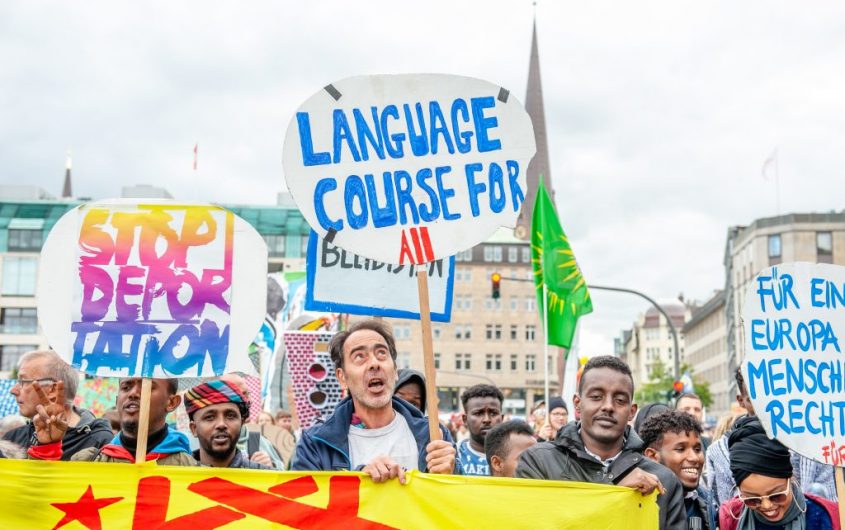
NurPhoto via Getty Images
Seventy Years as a Country of Immigrants: What’s Next for Germany?

Susanne Dieper
Director of Programs and Grants
Susanne Dieper is the Director of Programs and Grants at AICGS. She oversees the Institute’s programs and projects within the three AICGS program areas, manages all AICGS fellowships, and is in charge of grant writing. Her current focus is on issues related to transatlantic relations, immigration and integration, diversity, the next generation of leaders, workforce education, and reconciliation. She develops programs that align with the mission of AICGS to better understand the challenges and choices facing Germany and the United States in a broader global arena.
Previously, Ms. Dieper was in charge of organizational and project management at AICGS as well as human resource development and board of trustees relations. Prior to joining AICGS, she worked in transatlantic exchange programs, language acquisition, as well as the insurance industry in Germany.
Ms. Dieper holds an MBA from Johns Hopkins University with a concentration in International Business and an MA in English Linguistics and Literature, History, and Spanish from the University of Cologne. She has completed course work in nonprofit management at Johns Hopkins University.
__
In its seventy-year history, the Federal Republic of Germany has always been a highly desired destination for immigrants, not unlike some of its European neighbors and the United States. This may seem surprising to some, given the country’s citizenship law based on ius sanguinis (blood line) and the internal struggle Germany has had with declaring itself a country of immigration. In the aftermath of World War II, those immigrants who came to (West) Germany were predominantly German nationals or ethnic Germans (from Poland, Hungary, Czechoslovakia). Immigration from East Germany before 1961 was also significant and did not end completely even after the Wall was erected. The integration of these other “Germans” was considered successful, in part because of their German background and language skills (and their “German-ness”; they were not viewed as foreigners) and because Germany had many jobs to fill.
By the early 1990s, after the Iron Curtain had been lifted, and the composition of ethnic Germans had begun to change (most now came from the former Soviet Union with limited German language abilities), the German government had instituted a few changes, limiting the annual number of ethnic Germans that were allowed to immigrate to Germany and providing incentives for many to remain in their current home state. In addition, individuals from eastern European countries had to prove that they were facing discrimination at home in order to be allowed to immigrate to Germany.
A Different Wave of Immigrants: German Unease and Change
With the decreasing number of “German” immigrants arriving already in the late 1950s, and especially after the Wall was built in 1961, Germany needed additional workers (for mostly low-skilled jobs) and introduced its guest worker program. Those guest workers, who were expected to return to their home countries, came mostly from Italy, Spain, Greece, Yugoslavia, and Turkey. By 1973, the share of foreigners in Germany reached 6.7 percent of the total population. While some workers had returned, many had acquired residency status and brought their families. The second generation of guest worker families, born and raised in Germany, were not granted citizenship (due to ius sanguinis), an impediment to full integration and developing a sense of belonging. Generally, the goal was not to integrate the guest workers and the consensus was that they were not even considered immigrants. As a result, second generation guest workers were not provided with the tools that would help them integrate and become accepted by society.
Official acknowledgement of the fact that Germany is indeed a country of immigrants led to a change in the public narrative as well.
At the same time, in the 1990s, the number of asylum seekers (mostly from continental Europe) increased significantly and Germany experienced a rush of xenophobia that resulted in violent attacks against foreigners and asylees. The governing administration under Chancellor Helmut Kohl (CDU) for its part refused to consider Germany a country of immigrants. A change in attitude came with a change of government in 1998, when an SPD and Green coalition government was elected. Official acknowledgement of the fact that Germany is indeed a country of immigrants led to a change in the public narrative as well. Political leadership, the media, civil society, and private sector leaders all played an instrumental role in shaping an emerging public consensus regarding immigration and integration. As a result, Germany became one of the more open and immigration-friendly countries in Europe. It also paved the way for a significant overhaul of immigration and citizenship regulations (in 2000, 2005, and 2012) and, for the first time, the development of an integration policy.
Willkommen to Germany
Some important aspects of the immigration and integration debate in Germany—once the question of being a country of immigration was settled—included the question of whether someone could actually be German without having German ancestry and how the demographic change, with different ethnicities, would inform the question of identity. In 2010, SPD politician Thilo Sarrazin published an anti-immigrant book that accused Arab and Turkish immigrants in Germany of being unwilling to integrate. Although many were outraged, the general public seemed to share the sentiment. Subsequently, Chancellor Merkel, irritated by the whole affair, famously declared that multiculturalism, where people of different cultures and background live side by side without integrating, had failed. At the same time, Merkel declared the need for a skilled labor force in Germany, given its aging society and Germany’s continued dependence on foreign workers.
Germans have become generally more open-minded vis-à-vis immigrants, their culture and traditions, at the same time demonstrating respect and acknowledging the contributions immigrants make to German society.
The resulting policy of a Willkommenskultur and Anerkennungskultur (a culture of welcoming and acceptance of immigrants) offered an alternative to the failed multiculturalism and was largely supported by political and private sector leaders, civil society, and shared by the public. Integration is not a one-way street but has to be shaped by both host and immigrant. Through this new system or concept, Germans have become generally more open-minded vis-à-vis immigrants, their culture and traditions, at the same time demonstrating respect and acknowledging the contributions immigrants make to German society. Despite the struggle and internal debate around the issue of immigration and integration, right-wing, anti-immigrant voices were largely drowned out by this pro-immigrant consensus until 2017, when the Alternative for Germany (AfD) received more than enough votes to enter the German parliament.
Refugees in 2015 and Beyond
When Germany admitted almost one million refugees into the country in 2015, the pro-immigrant consensus was still mostly in place. The Willkommenskultur was on full display and demonstrated by ordinary citizens, politicians, private industry, and civil society. Economic success largely determines the degree of acceptance of foreigners in any country. Germany’s economy remains strong and the unemployment rate in both 2015 and 2016 was at a record low (and in 2018 and 2019 decreased further to 5.2 percent). Despite a positive economic picture, various government policies that have reduced the flow of migrants to a trickle, and the fact that applications for asylum are at the lowest point since 2015, the issues of immigration, integration, refugees, and foreigners were among the most important issues for voters in the 2017 parliamentary election.
Arguably, many factors can be identified as posing a threat to the pro-immigrant consensus. Even with a low unemployment rate, social inequality is felt intensely in Germany, anti-globalization and populist forces are thriving in Europe, and the question of identity continues to concern large sections of society. Furthermore, the continued public discussion about migration and diversity and what it means to be German (and what Germany’s “leading culture” looks like), demonstrate a sense of social insecurity in Germany. Indeed, the strength of the Willkommenskultur among the population had diminished somewhat between 2011 and 2017: the belief that cultural diversity is a positive decreased from 78 percent to 72 percent. Furthermore, integration efforts and successes are not uniform but rather depend on the Bundesland (state). Social policies that are inclusive and apply to all residents, regardless of their ethnic background, are an important tool for governments to ease the tension.
Economic success largely determines the degree of acceptance of foreigners in any country.
The recruitment of immigrants—mostly the high-skilled type—remains a priority at the federal level. The coalition government passed Germany’s first real immigration law in December 2018. The Fachkräftezuwanderungsgesetz (skilled employees immigration law) will make it easier for non-EU citizens to work in Germany. Despite the enthusiastic and urgent support from employers across industries, the law has been held up because of internal coalition disagreements regarding certain asylum provisions that are included in the law. For now, the law remains on hold and Germany is awaiting the next phase as a country of immigrants. What remains a fact is that Germany is more diverse than ever: in 2017, 23.6 percent of the population or 19.3 million people had a migration background. More than half of them are German nationals and, hopefully, many more will follow.
Read more on the 70th anniversary of the Federal Republic of Germany
From Fear to Friendship: Franco-German Relations in 1949 and 2019 by Lily Gardner Feldman
From Bonn to Berlin: Seventy Years of the FRG by Jackson Janes
Sovereignty Regained, Economic Order Uncertain: Germany’s Social Market Economy at 70 by Peter Rashish
The 70th Anniversary of the Federal Republic of Germany: Challenges and Opportunities for the German-American Future and the Atlantic Community by Jeff Rathke
The Past Shapes the Future: The German Constitution at 70 by Stephen F. Szabo






